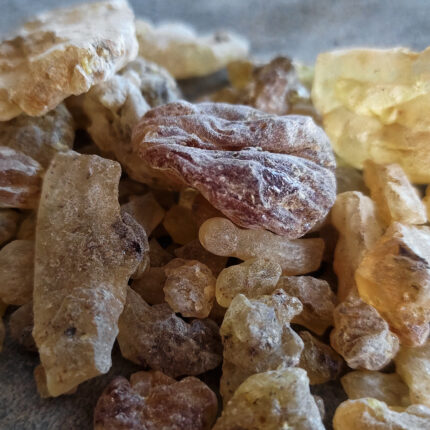

Agarwood resin, Colophony (Aquilaria malaccensis)
€10.00 – €45.00
Scientific name: Aquillaria malaccensis
Famiglia: Tymeliaceae
Origin: Merauke Papua New Guinea (Indonesia)
Warning: this resin has been distilled to extract the Oud, otherwise it would not have this price, but to make your stick incense it will always have the ability to release its classic Agarwood deep sweetness.
Not recommended to buy it to put on charcoal.
Premise
This essence is the result of an aggression of one or more mushrooms inside the stem of some trees of the genus Aquilaria, the most famous being Aquilaria malaccensis.
Until a few decades ago this wood was collected spontaneously in the forests of Southeast Asia, from Cambodia, Vietnam to Indonesia, it must have been fallen or felled and left on the ground even for years.
Fortunately now it is no longer cut down wild but cultivated and wounded specifically and applied the mycelium.
Some descriptions
Aquilaria malaccensis is a tropical tree that produces agarwood in its trunk often after being injured and attacked by pathogens or insects. Fungi are generally considered to be the main microbial component responsible for the formation of agarwood. In this study, isolation of fungi from agarwood in damaged trees was performed. Conventional culture methodology revealed the Cunninghamella, Curvularia, Fusarium and Trichoderma species as members of the agarwood community.
The injured trunks of A. malaccensis in the natural environment host numerous fungal taxa that exist in a complex system as a whole or in succession that leads to the production of agar wood in the tree trunk.
OUD
OUDs are very dense resinous compounds (oleoresins) which impregnate the heart of the wood with trees belonging to the Aquilaria genus, of the Thymelacee family, large evergreen plants native to Southeast Asia. This resin is particularly aromatic when released from the tree to protect itself from the attack of the mushroom Phaeoacremonium parasiticum and the wood is all the more valuable the richer in resin. Before the microbiological attack the resinous heart of the wood is soft, completely odorless, white or slightly colored in light while after the infection it changes color precisely due to the production of the resin, dark aromatic and rich in terpene compounds, which has the purpose of block or slow down the growth of the parasite. As the infection progresses, the density of the wood increases, first involving the wood of the trunk and then also the roots. The color of the wood turns dark brown or black. The wood of a plant not infected with the fungus has no interest in the cosmetic field, a partially infected tree still alive will be cut and used for the extraction of the OUD (essential oil) while a dead tree, or heavily attacked by the fungus, will instead used for the sale of its precious wood. Essential oils are generally colorless, especially when they are fresh, but they become colored when aged and are distinguished in “reddish brown” and “greenish brown”. The quality of OUD oil seems to be judged by its taste: the more bitter, the more valuable it is. Aquilaria malaccensis is considered the queen of the oud producing plants; there are also other plants, always of the genus Aquilaria, that grow in African regions such as Ethiopia. In natural forests only 7% of trees are infected with the fungus and since most of the genera of Aquilaria are endangered, oud is scarcely available and therefore very expensive.
Warm, woody, earthy aroma with sweet and slightly spicy notes, one of a kind.
The resin is never used pure to make incense, but it is pulverized and added to a small part of the powder of various woods and other resins.
This product is also used as Ambergris (Capitol’s food bolus), it can be a good fixative and enhances all the other added flavors.
If you want to try, ask for a sample, I’m happy to send, only with the purchase of something.
For shipments outside Italy, use as a plastic bag, to avoid damage and reduce the shipping price. Anyone wishing to have the glass bottle contact me. Thank you!
My job is to export raw materials, especially from Africa, if you have requests for more quantity I am at your disposal for a quotation consistent with your request.
My list boasts over 350 varieties of products.
| Weight |
10 gr ,25 gr ,50 gr |
|---|


























